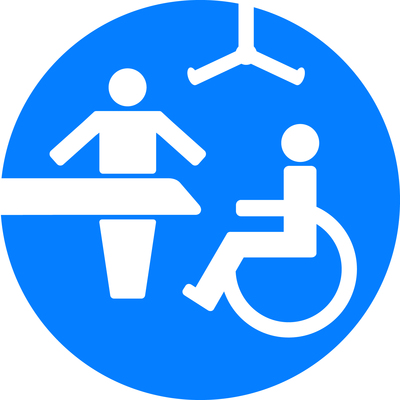Creating an Accessible Facility: 4 Key Considerations for Installing a Changing Places Toilet
Installing a Changing Places toilet can make a huge difference in the lives of people with disabilities. These specialized toilets are equipped with features that make them accessible to a wide range of people with disabilities, including those who require extra space, hoists, or changing benches. If you're planning to install a Changing Places toilet in your facility, there are a few key things to consider. In this article, we'll explore four things you should keep in mind as you plan your installation.
1. Choosing the Right Location for Your Changing Places Toilet Installation
The location of your Changing Places toilet is crucial. It should be easy to find, and ideally located near other accessible facilities like parking spaces and ramps. It should also be located in a quiet and private area to ensure that users feel comfortable and safe.
When choosing a location, consider the size of the toilet as well. Changing Places toilets are larger than standard accessible toilets and require more space. You'll need to make sure that the location you choose has enough room to accommodate the toilet, as well as any necessary equipment like hoists and changing benches.
2. Creating a Truly Accessible Experience with Your Changing Places Toilet
Accessibility is the main goal of a Changing Places toilet, so it's important to ensure that your installation is as accessible as possible. The toilet should be easy to use and should include features like grab bars, support rails, and non-slip flooring.
In addition, the toilet should be equipped with a hoist to help users transfer from their wheelchair to the toilet. Changing Places toilets should also have a height-adjustable changing bench to make changing easier for people who require assistance.
3. Maintaining Your Changing Places Toilet: Tips for Cleanliness and Comfort
Maintaining your Changing Places toilet is important to ensure that it remains clean and safe for users. You'll need to develop a maintenance plan that includes regular cleaning and upkeep of the toilet and any associated equipment.
In addition, you'll need to make sure that the toilet is well-stocked with supplies like toilet paper, paper towels, and soap. You should also consider installing a baby changing table in the same location, to help accommodate families with young children.
4. Meeting Guidelines and Regulations for Your Changing Places Toilet Installation
When it comes to installing a Changing Places toilet in the UK, it's important to be aware of the regulations and guidelines that apply. In the UK, Changing Places toilets are not currently a legal requirement under the Building Regulations, but they are included in the British Standard BS 8300:2018 which covers inclusive design for the built environment.
The British Standard recommends that Changing Places toilets be installed in any new large building or major refurbishment where visitors are likely to stay for a long time or where there is a high level of use. The standard also provides guidance on the minimum size, location, and features of a Changing Places toilet.
In addition to the British Standard, there are other regulations that may apply depending on the specific location and use of the Changing Places toilet. For example, in Scotland, Changing Places toilets are included in the Building Standards (Scotland) Regulations 2019, which require them to be installed in certain types of buildings.
To ensure compliance with all relevant regulations and guidelines, it's important to do your research and consult with experts in the field of inclusive design. You may also want to consider seeking advice from local authorities or disability advocacy groups.
By taking the time to understand the regulations and guidelines that apply to Changing Places toilets in the UK, you can ensure that your installation meets the needs of your users and complies with all relevant standards.
You'll also need to ensure that your installation meets the guidelines set forth by the Changing Places Consortium, which provides guidance on the design and installation of Changing Places toilets.

Conclusion
Installing a Changing Places toilet is an important step in making your facility or location more accessible to people with disabilities. By considering these four factors - location, accessibility, maintenance, and regulations - you can ensure that your installation meets the needs of your users and complies with all relevant guidelines.
FAQs
-
What is a Changing Places toilet?
A Changing Places toilet is a specialized accessible toilet equipped with features like hoists, changing benches, and extra space to accommodate a wide range of disabilities. -
Who benefits from a Changing Places toilet?
A Changing Places toilet benefits people with disabilities who require extra space, hoists, or changing benches to use the restroom. -
What are the regulations for installing a Changing Places toilet?
To install a Changing Places toilet, you must comply with relevant regulations and the guidelines set forth by the Changing Places Consortium. -
What is the maintenance required for a Changing Places toilet?
A Changing Places toilet requires regular cleaning and upkeep, as well as stocking with necessary supplies like toilet paper, paper towels, and soap. -
Can a Changing Places toilet be installed in any location?
While a Changing Places toilet can technically be installed in any location, it's important to choose a location that is easily accessible and can accommodate the larger size -
What is the cost of installing a Changing Places toilet?
The cost of installing a Changing Places toilet varies depending on a number of factors, including the location, size, and features required. However, it's important to remember that the cost is a worthwhile investment in making your facility more accessible and inclusive. -
Can a standard accessible toilet be used in place of a Changing Places toilet?
While a standard accessible toilet may be adequate for some people with disabilities, it may not be sufficient for those who require additional features like hoists and changing benches. A Changing Places toilet provides a more comprehensive and inclusive solution for people with a wide range of disabilities. -
What are some benefits of installing a Changing Places toilet?
Installing a Changing Places toilet can improve accessibility and inclusivity for people with disabilities, increase the usability of your facility or location, and demonstrate a commitment to diversity and inclusion. -
How can I ensure that my Changing Places toilet is being used appropriately?
To ensure that your Changing Places toilet is being used appropriately and is available to those who need it, you can consider implementing a system for booking or monitoring the use of the toilet. This can help prevent misuse and ensure that the toilet is available when needed. -
Are there any grants or funding available for installing a Changing Places toilet?
There are a number of grants and funding options available for organizations looking to install a Changing Places toilet. You can research local and national grant opportunities, or consider fundraising efforts to cover the cost of installation.
By considering these factors and taking steps to ensure that your Changing Places toilet is accessible, well-maintained, and compliant with regulations, you can make a significant difference in the lives of people with disabilities. Installation of a Changing Places toilet is a valuable investment in creating a more inclusive and accessible environment for all.





